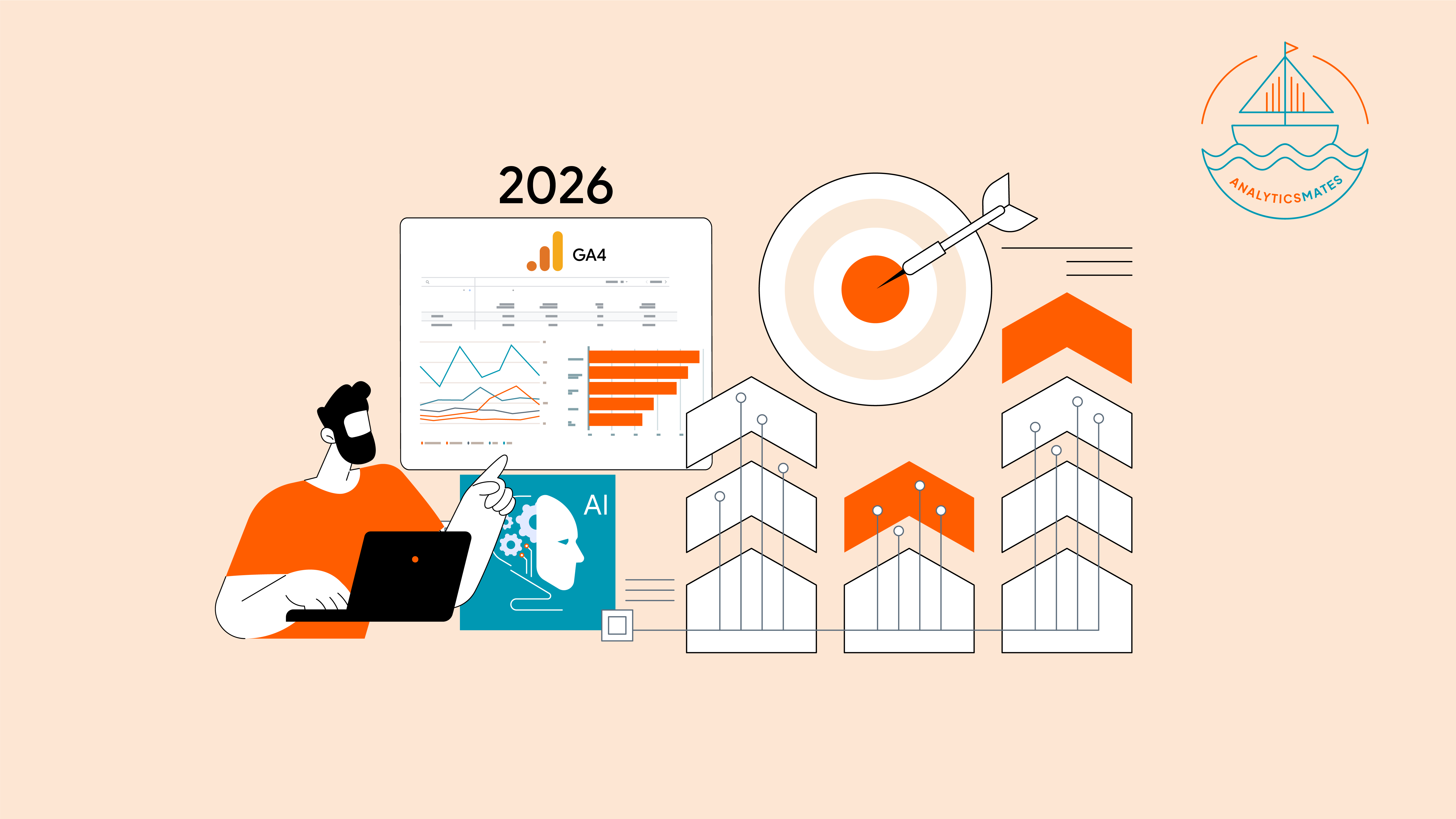If you’ve read our previous post, “Smarter SEO with GA4 and AI: A Practical Guide for Marketers,” you know how powerful data can be when it comes to uncovering what’s working and what isn’t in your search performance. GA4 and Google Search Console (GSC) give us the raw insights we need, but data without action is just noise.
In this post, we’re taking things one step further. It’s time to move from analyzing performance to building a plan that actually drives results. I’ll walk you through how to take your GA4 and GSC insights, layer in AI (like ChatGPT), and turn all that information into a 90-day SEO content calendar. Think of this as your bridge between “what happened” and “what we should do next.”
Gather Key SEO Performance Data
A strong SEO content strategy starts with understanding which pages are pulling their weight and which ones might be underperforming. As we’ve mentioned in previous posts, GA4 and Google Search Console are goldmines for this kind of insight, if you know what to look for. Here’s how you can begin:
Identify your top overall pages
Look at which pages are driving the most traffic or leads. These pages often represent the content that attracts an audience. In GA4 or in if you have a Google Looker Studio dashboard. You can check your site pages either when you're using your custom dashboard or directly through GA4 UI.
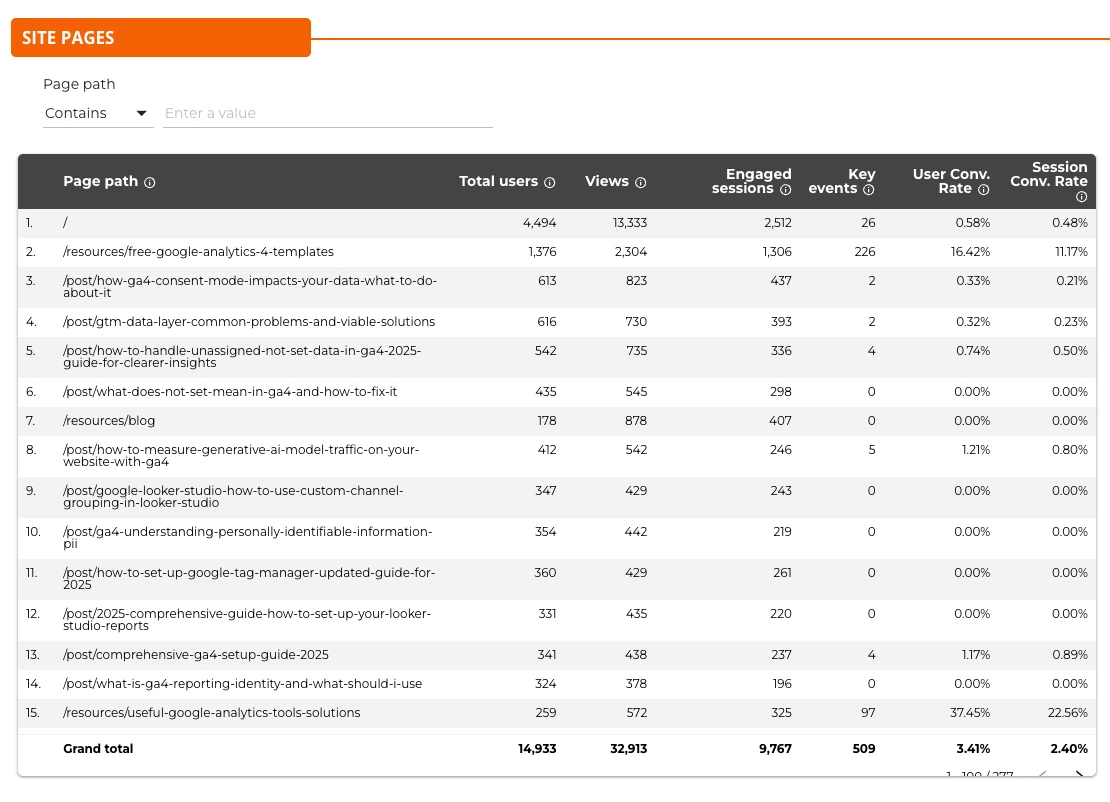
Focus on top blog pages
Same with the overall pages, you can further drill down by filtering specifically for blog content to see which posts are attracting readers. This helps you understand the type of topics and formats that work best.
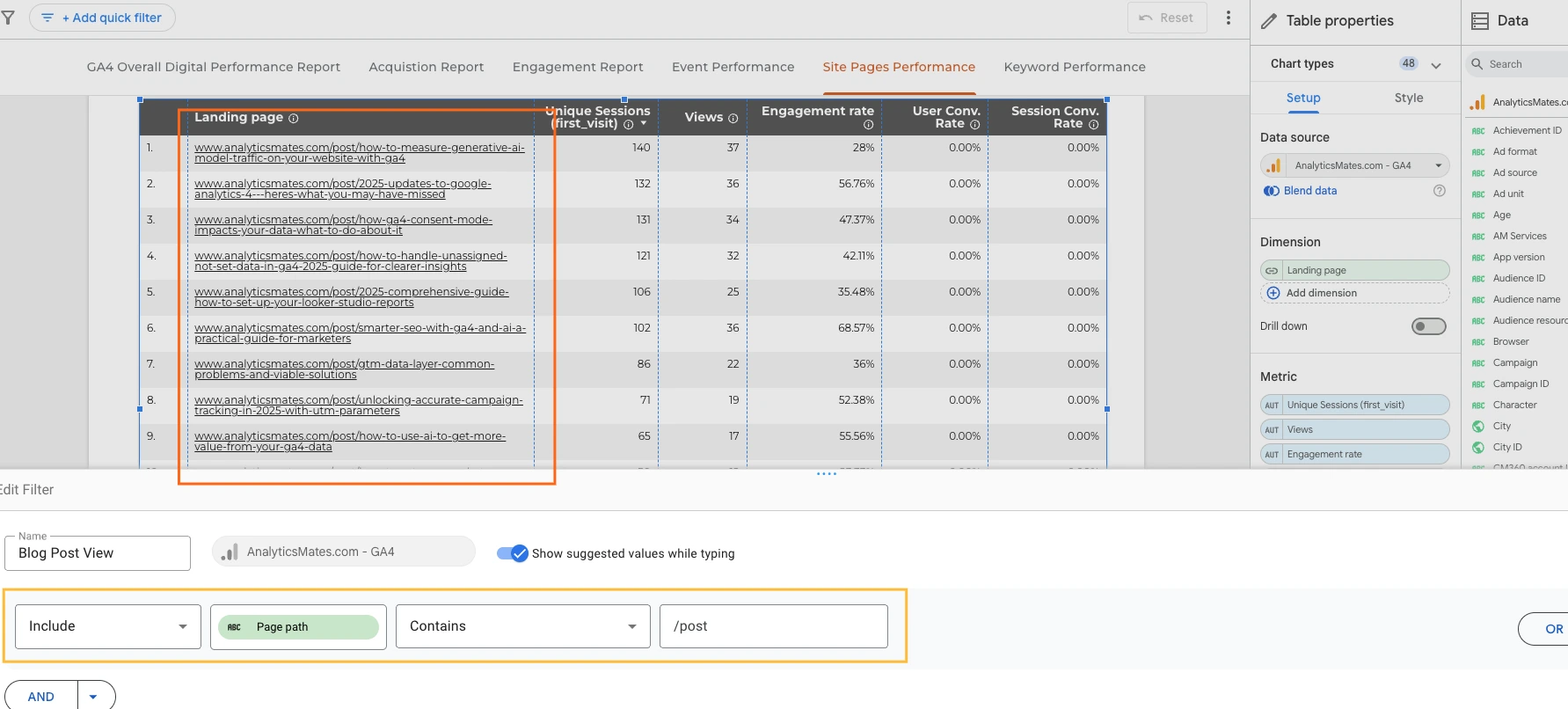
Check top organic-only pages
Apply an organic traffic filter to highlight pages that owe their success to SEO rather than paid or direct traffic. For this one, we’ll show you how to do it in GA4.
- In GA4 reports, go to Engagement → Pages and screens
- Add Session Default Channel Grouping as secondary dimension
- And filter by Organic Search channel grouping
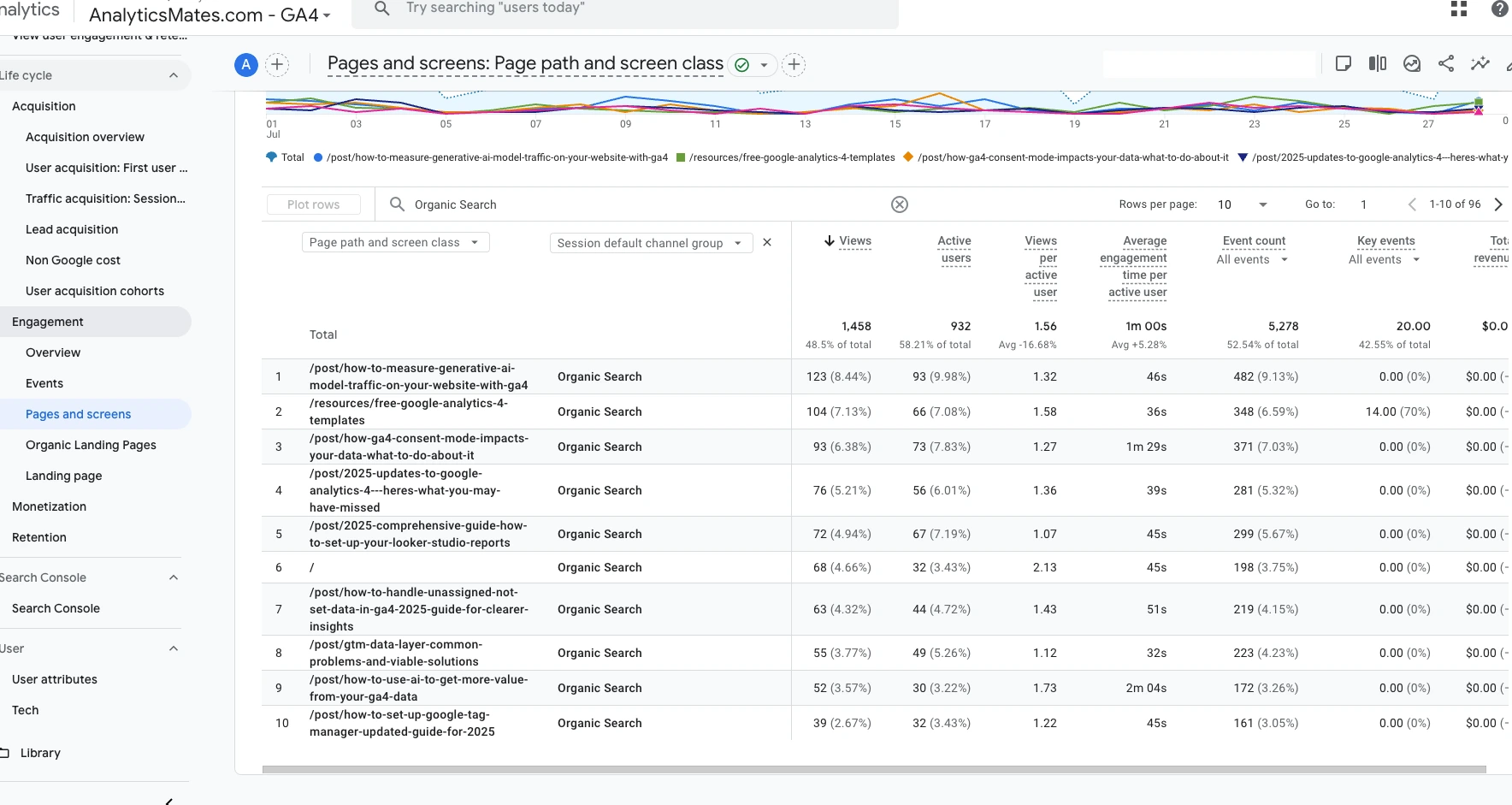
Or simply download the raw data directly from GA4 and prompt your AI tool to list down all pages from Organic Search channel grouping.
Spot high-impression but low-ranking pages (GSC)
Find pages that appear frequently in search results but rank below position 10. These are ripe for optimization since they already have visibility. A more efficient way to do this is to download or export data directly from your Google Search Console, based on the period you need.

Once you have the raw data you can feed this in your preferred AI tool and run a prompt.
Example AI Prompt:
Analyze this Google Search Console data and identify all pages (URLs) that frequently appear in search results (high impressions) but rank below position 10. Highlight those with decent click-through rates or potential for improvement. Recommend which pages to prioritize for optimization and suggest possible on-page improvements, such as title tag tweaks, meta descriptions, or content enhancement opportunities based on the search queries.
Identifying pages that are driving high-quality conversions.
But we’re not just talking about numbers here, or the volume of traffic. Also consider looking at which pages are encouraging users to take valuable actions or converting, such as filling out forms or booking consultations.
This initial step is important, because it sets how you’ll instruct AI in analyzing these datasets. And always remember that you can use AI as early as this stage in order to collect better insights that you’ll need in the next steps.
Use AI to Identify Gaps and Opportunities
Once you’ve gathered that information that you need like for example the content performance data, it’s time to put AI to work. As we always share, you don’t need to worry, this step isn’t about handing over control to AI. It’s more about using AI as a smart, strategic tool or assistant to identify gaps or patterns and opportunities you might have missed.
Start by uploading your datasets into an AI tool like ChatGPT. This could include export files from Google Search Console, keyword research tools, or content audits. From here, guide the AI with targeted prompts. For example:
- “What themes or keywords are missing from this content? And based on these datasets, what SEO topics should we focus on over the next 90 days?”

We know that AI can quickly go through the data and can spot gaps, overlapping topics across pages, or even content formats that are trending but underused in your strategy. If this isn’t efficient, what do you call this? Especially since it saves you the time to manually scan spreadsheets, AI gives you a high-level view and surfaces insights you can act on fast.
If you want to go further and be more efficient, focus your prompts around specific goals like traffic growth, improved rankings, or audience engagement. This ensures the AI output stays relevant and strategic.
Build Your AI-Informed Content Calendar
Now that you have the data and have already identified the opportunities, in this next step, your goal is to shape those insights into a focused plan. A 90-day content calendar is the ideal framework, it’s short enough to stay flexible, but long enough to track performance and see meaningful results. Here’s how to build yours:
Group content by funnel stage or intent
Organize topics based on where they fit in the customer journey. Some posts may be leaning toward awareness (like “how-to” guides), while others might focus on conversion, such as services or product comparisons or customer success stories.
Prioritize by opportunity
You need to focus first on ideas with high search potential, visible keyword gaps, or strategic alignment with your brand goals. You can always lean on AI’s insights to guide your decisions, but remember to use your judgment to pick what makes the most impact.
Set Your Content Flow
Decide how often you're going to put out new content (like blog posts) and then stick to that plan.Choose a schedule you can really manage, like once a week, or twice a month, and try your best to always publish on time. Being consistent is the most important thing.
Make it visual and shareable
For added clarity and also so it can be shareable, turn your calendar into a visual format or downloadable file. A simple spreadsheet or shared doc can help everyone stay on track and understand your content plans.

Here an example AI prompt that you can use:
Using my SEO data and identified opportunities, create a 90-day content calendar. Group content ideas by funnel stage or intent (awareness, consideration, conversion). Prioritize blog topics with high search potential, keyword gaps, and strategic alignment with brand goals. Set a realistic publishing schedule (e.g., weekly or bi-weekly) and ensure the calendar is in a clear, visual format, like a spreadsheet, that’s easy to follow and share.
Grab Your Free Resource: Analytics Mates – Top 25 AI Prompts to Optimize Your SEO Content Strategy
Want to take the guesswork out of planning and optimizing your content? We’ve put together “Analytics Mates: Top 25 AI Prompts to Optimize Your SEO Content Strategy”, a free PDF packed with ready-to-use prompts designed to help you:
- Generate high-impact blog ideas from your GA4 and GSC data
- Identify and close keyword gaps faster
- Optimize existing content for better rankings and conversions
- Build smarter content calendars with less effort
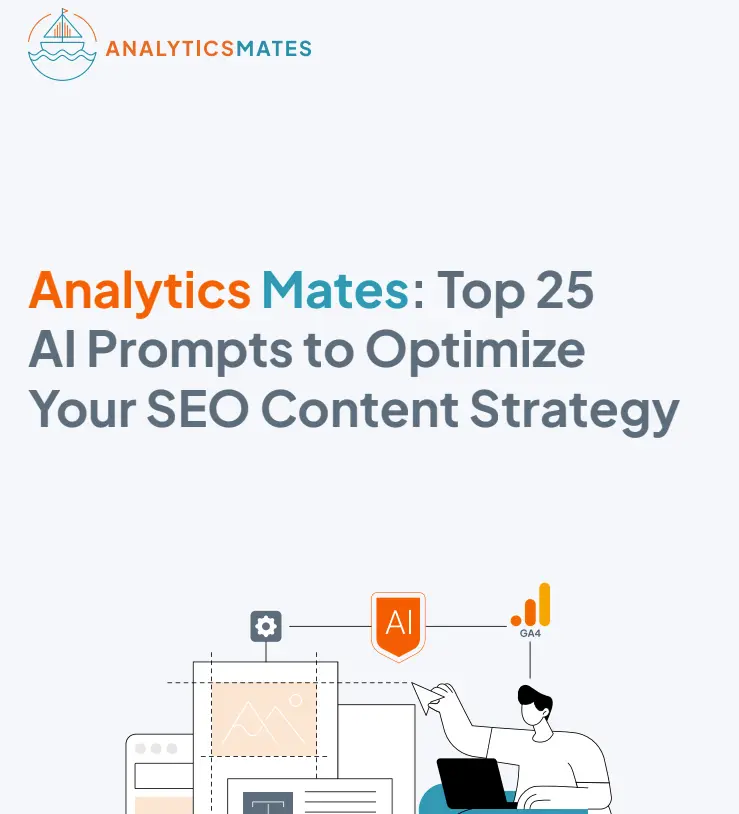
With these 25 prompts, you’ll have a toolkit that turns your data into actionable steps and should be perfect for marketers who want clarity, focus, and real results.
FAQs
Do I need paid AI tools for this process?
A:Not necessarily. Free versions of tools like ChatGPT can still handle basic analysis if your datasets are well-structured.
What’s the best way to prepare GA4 data for AI?
A: Export clean, summarized data tables—like top pages, conversions, and keywords—so AI can process them without confusion.
How often should I update my content calendar?
A: A quarterly review is ideal, but you can adjust monthly if your industry moves fast.
Can this approach replace traditional SEO audits?
A: No, but it complements audits by helping you move from findings to action quickly.
Is this strategy suitable for small websites?
A: Absolutely. Even a small site benefits from understanding top pages and keyword opportunities.
How do I prioritize content ideas AI suggests?
A: Look for overlap between AI recommendations and your conversion data—topics that bring both traffic and leads are gold.
What if AI suggests irrelevant topics?
A: Use human judgment to filter out ideas that don’t align with your brand or audience.
Can I use this method for non-blog content like videos or landing pages?
A: Yes, the same data-driven approach works for any content format.
How does GA4 differ from Universal Analytics for SEO?
A: GA4 focuses more on events and engagement metrics, which can reveal deeper insights into content performance.
What’s next after building a 90-day plan?
A: Monitor performance, tweak your strategy, and keep refining future content based on fresh data.
Conclusion
Wrapping this up with this: it's not about going after the newest AI tool or that next big GA4 update. It's about using what's already right there at your fingertips.The key here is to always stay curious, think of trying new things often, and ensure that you consider AI as helpful in your daily work, not something that replaces you.
Download the AI Prompt Cheat Sheet we’re sharing, it's a great way to start making your next SEO steps sharper, quicker, and simply more effective. Remember, the future of search truly belongs to marketers who know how to use data wisely, and that absolutely includes you.
Thank you for reading!
We're always looking for ways to improve our Google Analytics 4 blog content. Please share your feedback so we can make it even better.
See Article Images









